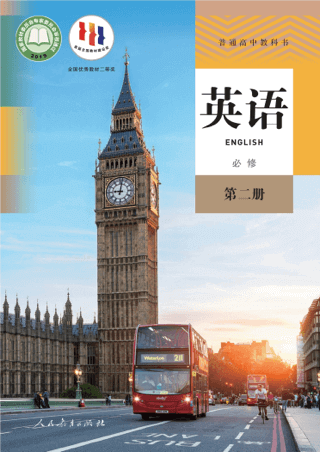英语人教版必修二课文目录
UNIT 1 CULTURAL HERITAGE课文翻译及听力音频
UNIT 1 CULTURAL HERITAGE 翻译:第 1 单元 文化遗产
Heritage is our legacy from the past, what we live with today, and what we pass on to future generations. 翻译:历史遗迹是我们过去的遗产,是我们今天拥有的东西,也是我们留给后代的东西。
—World Heritage Centre. 翻译: ——世界遗产中心
Listening and Speaking 翻译:听力和口语
2 Listen to the conversation and choose the main idea. 翻译:2 听对话,选择主题。
—Hello, what are you guys doing? 翻译:——你好,你们在做什么呢?
—We're creating an app about Mount Tai. We're part of an international youth project. 翻译: ——我们正在创建一个关于泰山的应用程序。我们是一个国际青年项目的一部分。
—That's interesting. How many students are taking part in the project? 翻译: ——真有趣。有多少学生参加这个项目?
—There are twenty-three senior high school students from seven countries. 翻译: ——有来自七个国家的二十三名高中生。
—Why is the project here at Mount Tai? 翻译: ——为什么项目会在泰山这里进行?
—Well, as you know, Mount Tai is one of the most famous mountains in China. The mountain and the temples have been protected for over three thousand years. So it's a great example of how people preserve their cultural heritage. We feel so proud to have a chance to do something. 翻译: ——嗯,你知道的,泰山是中国最著名的山之一。这座山和寺庙已经被保护了三千多年。所以它是人们如何保护文化遗产的一个绝佳例子。我们感到非常自豪能够有机会做点什么。
—Tell me about the app you're making. 翻译: ——告诉我一下你们正在制作的应用程序吧。
—We want to promote Mount Tai, that is, we want to tell teenagers in other countries about the mountain and Chinese culture. The app teaches teenagers about Mount Tai and even has a few games about cultural relics. 翻译: ——我们想推广泰山,也就是说,我们想向其他国家的青少年介绍泰山和中国文化。这个应用程序教青少年关于泰山的知识,甚至还有一些关于文物的小游戏。
—Oh, that's a clever idea! 翻译: ——哦,这是个聪明的主意!
—Yes. For example, this game is about the six cypresses that were planted on Mount Tai during the Han dynasty. You learn about the trees and also the life in China over two thousand years ago. 翻译: ——是的。例如,这个游戏是关于六棵柏树的,它们是在汉代时种在泰山上的。你可以学习到关于这些树的知识,还能了解两千多年前中国的生活。
—That sounds great! So what else will you put in the app? 翻译: ——听起来很棒!那你们还会在应用程序里加入什么内容?
—Well, there are twenty-two temples and some one thousand eight hundred stones with writing on them. We'll take photos of them all, and then visit the Dai Temple on Mount Tai, since it has so many important paintings and relics. Another group is reading about Mount Tai and writing texts for the app. We'll also visit local schools and talk to Chinese students. 翻译: ——嗯,泰山上有二十二座寺庙和约一千八百块有文字的石刻。我们会拍下它们的照片,然后参观泰山的岱庙,因为那里有很多重要的画作和文物。另一组正在阅读关于泰山的资料,并为应用程序撰写文字。我们还会参观当地的学校,与中国学生交流。
—Do you think that some people will use the app instead of visiting Mount Tai? 翻译: ——你觉得有些人会用这个应用程序代替来泰山参观吗?
—No, not a chance! The app is great, but the best way to see Mount Tai is the climb all six thousand steps! 翻译: ——不,绝对不可能!这个应用程序很棒,但看泰山的最佳方式就是爬上那六千多级台阶!
—What? How many steps? 翻译: ——什么?多少级台阶?
—More than six thousand! 翻译: ——超过六千级!
3 Listen again and help the reporter to complete the interview notes. 翻译:3 再听一遍,帮助记者完成采访笔记。
—Hello, what are you guys doing? 翻译:——你好,你们在做什么呢?
—We're creating an app about Mount Tai. We're part of an international youth project. 翻译: ——我们正在创建一个关于泰山的应用程序。我们是一个国际青年项目的一部分。
—That's interesting. How many students are taking part in the project? 翻译: ——真有趣。有多少学生参加这个项目?
—There are twenty-three senior high school students from seven countries. 翻译: ——有来自七个国家的二十三名高中生。
—Why is the project here at Mount Tai? 翻译: ——为什么项目会在泰山这里进行?
—Well, as you know, Mount Tai is one of the most famous mountains in China. The mountain and the temples have been protected for over three thousand years. So it's a great example of how people preserve their cultural heritage. We feel so proud to have a chance to do something. 翻译: ——嗯,你知道的,泰山是中国最著名的山之一。这座山和寺庙已经被保护了三千多年。所以它是人们如何保护文化遗产的一个绝佳例子。我们感到非常自豪能够有机会做点什么。
—Tell me about the app you're making. 翻译: ——告诉我一下你们正在制作的应用程序吧。
—We want to promote Mount Tai, that is, we want to tell teenagers in other countries about the mountain and Chinese culture. The app teaches teenagers about Mount Tai and even has a few games about cultural relics. 翻译: ——我们想推广泰山,也就是说,我们想向其他国家的青少年介绍泰山和中国文化。这个应用程序教青少年关于泰山的知识,甚至还有一些关于文物的小游戏。
—Oh, that's a clever idea! 翻译: ——哦,这是个聪明的主意!
—Yes. For example, this game is about the six cypresses that were planted on Mount Tai during the Han dynasty. You learn about the trees and also the life in China over two thousand years ago. 翻译: ——是的。例如,这个游戏是关于六棵柏树的,它们是在汉代时种在泰山上的。你可以学习到关于这些树的知识,还能了解两千多年前中国的生活。
—That sounds great! So what else will you put in the app? 翻译: ——听起来很棒!那你们还会在应用程序里加入什么内容?
—Well, there are twenty-two temples and some one thousand eight hundred stones with writing on them. We'll take photos of them all, and then visit the Dai Temple on Mount Tai, since it has so many important paintings and relics. Another group is reading about Mount Tai and writing texts for the app. We'll also visit local schools and talk to Chinese students. 翻译: ——嗯,泰山上有二十二座寺庙和约一千八百块有文字的石刻。我们会拍下它们的照片,然后参观泰山的岱庙,因为那里有很多重要的画作和文物。另一组正在阅读关于泰山的资料,并为应用程序撰写文字。我们还会参观当地的学校,与中国学生交流。
—Do you think that some people will use the app instead of visiting Mount Tai? 翻译: ——你觉得有些人会用这个应用程序代替来泰山参观吗?
—No, not a chance! The app is great, but the best way to see Mount Tai is the climb all six thousand steps! 翻译: ——不,绝对不可能!这个应用程序很棒,但看泰山的最佳方式就是爬上那六千多级台阶!
—What? How many steps? 翻译: ——什么?多少级台阶?
—More than six thousand! 翻译: ——超过六千级!
5 Listen to the conversation again and use the context to guess the meaning of the words below. 翻译:5 再听一遍对话,并根据上下文猜测下列单词的意思。
Tick the reason why you were able to guess the words. 翻译:勾出你能猜出单词的原因。
—Hello, what are you guys doing? 翻译:——你好,你们在做什么呢?
—We're creating an app about Mount Tai. We're part of an international youth project. 翻译: ——我们正在创建一个关于泰山的应用程序。我们是一个国际青年项目的一部分。
—That's interesting. How many students are taking part in the project? 翻译: ——真有趣。有多少学生参加这个项目?
—There are twenty-three senior high school students from seven countries. 翻译: ——有来自七个国家的二十三名高中生。
—Why is the project here at Mount Tai? 翻译: ——为什么项目会在泰山这里进行?
—Well, as you know, Mount Tai is one of the most famous mountains in China. The mountain and the temples have been protected for over three thousand years. So it's a great example of how people preserve their cultural heritage. We feel so proud to have a chance to do something. 翻译: ——嗯,你知道的,泰山是中国最著名的山之一。这座山和寺庙已经被保护了三千多年。所以它是人们如何保护文化遗产的一个绝佳例子。我们感到非常自豪能够有机会做点什么。
—Tell me about the app you're making. 翻译: ——告诉我一下你们正在制作的应用程序吧。
—We want to promote Mount Tai, that is, we want to tell teenagers in other countries about the mountain and Chinese culture. The app teaches teenagers about Mount Tai and even has a few games about cultural relics. 翻译: ——我们想推广泰山,也就是说,我们想向其他国家的青少年介绍泰山和中国文化。这个应用程序教青少年关于泰山的知识,甚至还有一些关于文物的小游戏。
—Oh, that's a clever idea! 翻译: ——哦,这是个聪明的主意!
—Yes. For example, this game is about the six cypresses that were planted on Mount Tai during the Han dynasty. You learn about the trees and also the life in China over two thousand years ago. 翻译: ——是的。例如,这个游戏是关于六棵柏树的,它们是在汉代时种在泰山上的。你可以学习到关于这些树的知识,还能了解两千多年前中国的生活。
—That sounds great! So what else will you put in the app? 翻译: ——听起来很棒!那你们还会在应用程序里加入什么内容?
—Well, there are twenty-two temples and some one thousand eight hundred stones with writing on them. We'll take photos of them all, and then visit the Dai Temple on Mount Tai, since it has so many important paintings and relics. Another group is reading about Mount Tai and writing texts for the app. We'll also visit local schools and talk to Chinese students. 翻译: ——嗯,泰山上有二十二座寺庙和约一千八百块有文字的石刻。我们会拍下它们的照片,然后参观泰山的岱庙,因为那里有很多重要的画作和文物。另一组正在阅读关于泰山的资料,并为应用程序撰写文字。我们还会参观当地的学校,与中国学生交流。
—Do you think that some people will use the app instead of visiting Mount Tai? 翻译: ——你觉得有些人会用这个应用程序代替来泰山参观吗?
—No, not a chance! The app is great, but the best way to see Mount Tai is the climb all six thousand steps! 翻译: ——不,绝对不可能!这个应用程序很棒,但看泰山的最佳方式就是爬上那六千多级台阶!
—What? How many steps? 翻译: ——什么?多少级台阶?
—More than six thousand! 翻译: ——超过六千级!
Pronunciation 翻译:发音
1 Listen and tick the word that you hear. 翻译:1 听录音,勾选你听到的单词。
1 present 翻译:1 目前
2 grew 翻译:2 成长
3 scream 翻译:3 尖叫
4 exists 翻译:4 存在
5 twelfth 翻译:5 第十二
6 confused 翻译:6 困惑的
Check your answers with a partner. Then listen again and repeat. 翻译:与伙伴核对你的答案。然后再听一遍并跟读。
1 present 2 grew 3 scream 4 exists 5 twelfth 6 confused 翻译: 1 目前 2 成长 3 尖叫 4 存在 5 第十二 6 困惑的
2 Read the sentences aloud and pay attention to the underlined words. 翻译:2 大声朗读句子,注意划线单词。
Then listen and tick the sentence that you hear. 翻译:然后听录音,勾选你听到的句子。
1 Yuanmingyuan? Just cross the street. 翻译:1 圆明园?就在街对面。
2 Bruce preferred the guidebook. 翻译:2 布鲁斯更喜欢这本旅游指南。
3 The dragon followed its trail. 翻译:3 龙跟随它的踪迹。
4 It is a different context. 翻译:4 这是一个不同的语境。
5 The trains were dark green. 翻译:5 火车是深绿色的。
3 Listen again and repeat. 翻译:3 再听一遍并跟读。
1 Yuanmingyuan? Just across the street. 翻译: 1 圆明园?就在街对面。
2 Bruce preferred the guidebook. 翻译: 2 布鲁斯更喜欢这本旅游指南。
3 The dragon followed its trail. 翻译: 3 龙跟随它的踪迹。
4 It is a different context. 翻译: 4 这是一个不同的语境。
5 The trains were dark green. 翻译: 5 火车是深绿色的。
Reading and Thinking 翻译:阅读与思考
2 Scan the text for numbers. Circle the numbers and guess what they mean. 翻译:2 浏览文本中的数字。圈出这些数字并弄清它们的意思。
FROM PROBLEMS TO SOLUTIONS 翻译:从问题到解决方案
Economic development is necessary if we want to improve society. 翻译:如果我们想改善社会,经济发展是必要的。
There comes a time when the old must give way to the new, and it is not possible to preserve everything from our past as we move towards the future. 翻译:总有一天,旧事物必须让位于新事物,在我们走向未来的过程中,不可能保留过去的一切。
Finding and keeping the right balance between progress and the protection of cultural sites can be a big challenge. 翻译:在进步和保护文化遗址之间找到并保持适当的平衡可能是一个巨大的挑战。
Big challenges, however, can sometimes lead to great solutions. 翻译:然而,巨大的挑战有时会带来伟大的解决方案。
In the 1950s, the Egyptian government wanted to build a new dam across the Nile in order to control floods, produce electricity, and supply water to more farmers in the area. 翻译:20 世纪 50 年代,埃及政府希望在尼罗河上修建一座新大坝,以控制洪水、发电,并为该地区更多的农民供水。
But the proposal led to protests. 翻译:但这一提议引发了抗议。
Water from the dam would likely damage a number of temples and destroy cultural relics that were an important part of Egypt's cultural heritage. 翻译:大坝的水可能会破坏一些寺庙,摧毁作为埃及文化遗产重要组成部分的文物。
After listening to the scientists who had studied the problem, and citizens who lived near the dam, the government turned to the United Nations for help in 1959. 翻译:在听取了研究该问题的科学家,以及住在大坝附近的公民的意见后,政府于 1959 年向联合国寻求帮助。
A committee was established to limit damage to the Egyptian buildings and prevent the loss of cultural relics. 翻译:政府成立了一个委员会,以限制对埃及建筑的破坏和防止文物的损失。
The group asked for contributions from different departments and raised funds within the international community. 翻译:该组织要求不同部门捐款,并在国际社会内筹集资金。
Experts investigated the issue, conducted several tests, and then made a proposal for how the buildings could be saved. 翻译:专家们调查了这个问题,进行了几次测试,然后就如何拯救这些建筑提出了建议。
Finally, a document was signed, and the work began in 1960. 翻译:最后,签署了一份文件,工作于 1960 年开始。
The project brought together governments and environmentalists from around the world. 翻译:该项目汇集了来自世界各地的政府和环保主义者。
Temples and other cultural sites were taken down piece by piece, and then moved and put back together again in a place where they were safe from the water. 翻译:寺庙和其他文化遗址被一块一块地拆除,然后在一个远离水的地方移动并重新组装。
In 1961, German engineers moved the first temple. 翻译:1961 年,德国工程师迁移了第一座寺庙。
Over the next 20 years, thousands of engineers and workers rescued 22 temples and countless cultural relics. 翻译:在接下来的 20 年里,数千名工程师和工人拯救了 22 座寺庙和无数文物。
Fifty countries donated nearly $80 million to the project. 翻译:50 个国家向该项目捐赠了近 8000 万美元。
When the project ended in 1980, it was considered a great success. 翻译:当该项目于 1980 年结束时,它被认为是一个巨大的成功。
Not only had the countries found a path to the future that did not run over the relics of the past, but they had also learnt that it was possible for countries to work together to build a better tomorrow. 翻译:这些国家不仅找到了一条没有超越过去遗迹的未来之路,而且还了解到,各国可以共同努力,建设更美好的明天。
The spirit of the Aswan Dam project is still alive today. 翻译:阿斯旺大坝项目的精神今天仍然存在。
Perhaps the best example is shown by UNESCO, which runs a programme that prevents world cultural heritage sites around the world from disappearing. 翻译:也许最好的例子是教科文组织,该组织实施了一项防止世界各地世界文化遗产消失的计划。
If a problem seems too difficult for a single nation, the global community can sometimes provide a solution. 翻译:如果一个问题对一个国家来说太难了,国际社会有时可以提供解决方案。
Listening and Talking 翻译:倾听和交谈
1 Listen to the conversation and choose the correct answers. 翻译:1 听对话,选择正确答案。
—OK, here we are: the Kremlin and Red Square. 翻译:——好了,我们到了:克里姆林宫和红场。
—Excuse me, but what is the Kremlin exactly? 翻译: ——请问一下,克里姆林宫到底是什么地方?
—The Kremlin is a special government area. Inside, there are five palaces and four cathedrals. It's where the president lives, too. 翻译: ——克里姆林宫是一个特殊的政府区域。里面有五座宫殿和四座教堂。总统也住在那里。
—Wow! A little bit like the Palace Museum in Beijing. 翻译: ——哇!有点像北京的故宫。
—Yes. I guess you could say that. The Kremlin was actually built around the same time, between the fourteenth and seventeenth centuries. 翻译: ——是的。我想你可以这么说。克里姆林宫其实大约在同一时期建成的,建于十四到十七世纪之间。
—What's that building over there, with the colorful round towers? I've seen so many photos of it. It looks so pretty, like a flame! 翻译: ——那边那个建筑是什么,带着彩色圆顶的塔?我看到过很多它的照片。它看起来真漂亮,像火焰一样!
—That's Saint Basil's Cathedral. People all over the world think of Russia when they see it. It's like the Eiffel Tower in France or the Great Wall in China, a symbol of the country. 翻译: ——那是圣瓦西里大教堂。全世界的人们看到它都会想到俄罗斯。就像法国的埃菲尔铁塔或中国的长城一样,是这个国家的象征。
—Forgive me for asking, but can you tell me more about Red Square? 翻译: ——请原谅我的提问,你能多介绍一下红场吗?
—Well, it's considered the centre of Moscow, and there have been many important parades and events held here. It also used to be a marketplace a long time ago. 翻译: ——嗯,它被认为是莫斯科的中心,这里举办过很多重要的阅兵和活动。很久以前它还曾是一个集市。
—Oh, really? How amazing! 翻译: ——哦,真的吗?太神奇了!
—I see that you're looking at the photos of an ice hockey game. Did you know that children can skate on Red Square in the winter? 翻译: ——我看你在看冰球比赛的照片。你知道冬天孩子们可以在红场上滑冰吗?
—No way! That's so cool! 翻译: ——不会吧!太酷了!
—Yes. Red Square is also a place for music concerts. People have a lot of fun here. 翻译: ——是的。红场也是音乐会的举办地。人们在这里玩得很开心。
2 What do you know about the Kremlin and Red Square? 翻译:2 你对克里姆林宫和红场了解多少?
Listen again and complete the fact sheet. 翻译:再听一遍,完成情况说明书。
—OK, here we are: the Kremlin and Red Square. 翻译:——好了,我们到了:克里姆林宫和红场。
—Excuse me, but what is the Kremlin exactly? 翻译: ——请问一下,克里姆林宫到底是什么地方?
—The Kremlin is a special government area. Inside, there are five palaces and four cathedrals. It's where the president lives, too. 翻译: ——克里姆林宫是一个特殊的政府区域。里面有五座宫殿和四座教堂。总统也住在那里。
—Wow! A little bit like the Palace Museum in Beijing. 翻译: ——哇!有点像北京的故宫。
—Yes. I guess you could say that. The Kremlin was actually built around the same time, between the fourteenth and seventeenth centuries. 翻译: ——是的。我想你可以这么说。克里姆林宫其实大约在同一时期建成的,建于十四到十七世纪之间。
—What's that building over there, with the colorful round towers? I've seen so many photos of it. It looks so pretty, like a flame! 翻译: ——那边那个建筑是什么,带着彩色圆顶的塔?我看到过很多它的照片。它看起来真漂亮,像火焰一样!
—That's Saint Basil's Cathedral. People all over the world think of Russia when they see it. It's like the Eiffel Tower in France or the Great Wall in China, a symbol of the country. 翻译: ——那是圣瓦西里大教堂。全世界的人们看到它都会想到俄罗斯。就像法国的埃菲尔铁塔或中国的长城一样,是这个国家的象征。
—Forgive me for asking, but can you tell me more about Red Square? 翻译: ——请原谅我的提问,你能多介绍一下红场吗?
—Well, it's considered the centre of Moscow, and there have been many important parades and events held here. It also used to be a marketplace a long time ago. 翻译: ——嗯,它被认为是莫斯科的中心,这里举办过很多重要的阅兵和活动。很久以前它还曾是一个集市。
—Oh, really? How amazing! 翻译: ——哦,真的吗?太神奇了!
—I see that you're looking at the photos of an ice hockey game. Did you know that children can skate on Red Square in the winter? 翻译: ——我看你在看冰球比赛的照片。你知道冬天孩子们可以在红场上滑冰吗?
—No way! That's so cool! 翻译: ——不会吧!太酷了!
—Yes. Red Square is also a place for music concerts. People have a lot of fun here. 翻译: ——是的。红场也是音乐会的举办地。人们在这里玩得很开心。
Reading for Writing 翻译:阅读写作
1 Read the news report and answer the questions. 翻译:1 阅读新闻报道并回答问题。
PROMOTING CULTURE THROUGH DIGITAL IMAGES 翻译:通过数字图像促进文化
<i>Lanzhou, 9 August 2017</i>. 翻译:兰州,2017 年 8 月 9 日。
A group of researchers and scientists from China and other countries are working together to help increase knowledge and appreciation of China's ancient cultural heritage. 翻译:来自中国和其他国家的一群研究人员和科学家正在共同努力,帮助增加对中国古代文化遗产的了解和欣赏。
They are recording and collecting digital images of cultural relics from the Mogao Caves, which were a key stop along the Silk Road throughout China's ancient history. 翻译:他们正在记录和收集莫高窟文物的数字图像,莫高窟是中国古代丝绸之路的重要一站。
Nearly 500, 000 high-quality digital photographs have been produced since the international project started in 1994. 翻译:自 1994 年国际项目启动以来,已经制作了近 50 万张高质量的数码照片。
The Mogao Caves have long been a meeting point for different cultures and are part of the history of many countries. 翻译:莫高窟长期以来一直是不同文化的交汇点,是许多国家历史的一部分。
Today, the caves are just as international as they were at the time when people travelled the Silk Road. 翻译:今天,这些洞穴和人们走丝绸之路时一样国际化。
Tourists from all over the world visit Dunhuang to see the caves, and the Getty Museum in Los Angeles has even reproduced a copy of the caves and paintings for people to admire in America. 翻译:来自世界各地的游客来敦煌参观洞穴,洛杉矶的盖蒂博物馆甚至复制了一份洞穴和绘画作品,供美国人欣赏。
By sharing so many digital photos over the Internet, the group hopes to promote even wider interest around the world in China's ancient history, culture, and traditions. 翻译:通过在互联网上分享如此多的数码照片,该组织希望促进世界各地对中国古代历史、文化和传统的更广泛兴趣。
They also hope to further educate people about the importance of safeguarding historic and cultural relics for future generations to understand and appreciate. 翻译:他们还希望进一步教育人们保护历史文化遗产的重要性,让子孙后代了解和欣赏。
As one researcher who is working on the project explains, 翻译:正如一位参与该项目的研究人员所解释的那样:
'Appreciating one's own cultural heritage is very important for understanding oneself. Appreciating the cultural heritage of other countries is very important for international communication and understanding.' 翻译:“欣赏自己的文化遗产对于了解自己非常重要。欣赏其他国家的文化遗产对于国际交流和理解非常重要。”
最新学习记录 更新时间:2025-12-16 12:44:13



 切换教材
切换教材